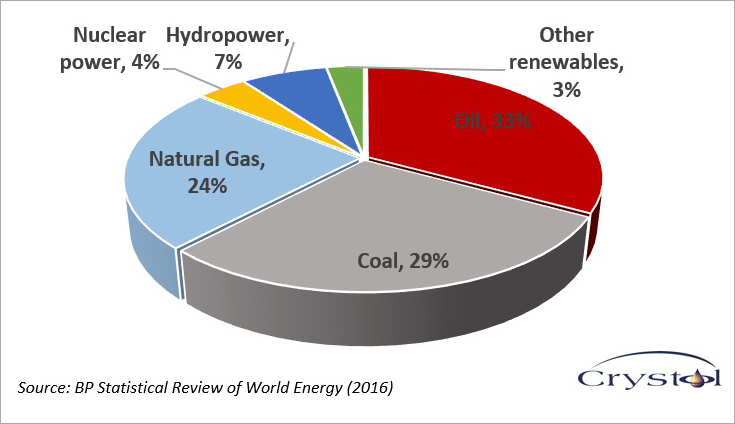Global Energy Trends: Is there a Revolution in the Making?
Evolution
For a long time, the history of global energy consumption has been marked by the dominance of a single fuel – first wood, then coal, then oil. But all along, the economic, political and technological forces have also altered the energy mix, often in unpredictable ways, as they have driven the transition from one dominant fuel to another. Today, the world’s fuel mix is much diversified than ever before. One of the key questions asked by many is how the evolution of the fuel mix will continue in the light of the new concern about climate change.
Looking back, coal displaced a traditional “renewable” (wood) as it fuelled the industrial revolution in the 19th century. Its supremacy only ended when oil entered into the picture. Originally only used for medical purposes (‘snake oil’) and lighting, the invention of electric light bulb almost rendered oil obsolete until a major disruptive technology came along, which continues to define modern societies today – the internal combustion engine. At the same time, oil acquired strategic importance when, back in 1913, Winston Churchill, then the Lord of the Admiralty, ordered the British fleet to change over from coal firing to oil.
For decades, the world enjoyed ample and cheap supplies of oil. The first oil crisis in 1973, however, came as a wake-up call, warning consuming nations about the dangers to security of relying on a single source of energy outside their control. The subsequent increase in oil prices gave further impetus to the search for alternative resources. Natural gas, initially often an unwanted by-product, became increasingly popular, especially in the power sector. An altogether new form of energy – nuclear power – emerged and was scaled up, although confined to a small number of countries. As concerns about climate change intensified, various forms of renewable energy – mostly wind and solar – started to occupy center stage in the energy policies of many (and mostly wealthy) countries, in addition to one of the world’s oldest renewable power sources, hydropower.
Today, the global primary energy mix looks more colorful than ever, but the dominance of fossil fuels remains its most prominent feature. Coal, oil and gas account for a staggering share of 86% of total fuel consumption, the rest is divided between “old” renewables, i.e. hydropower (7%), “new” renewables, i.e. wind, solar and biofuels (3%) and nuclear (4%) (Figure 1).[1]
Figure 1: Global Primary Energy Mix (2016)

Outlook
The concern about global warming, combined with the perception of visible and dramatic signs of the beginning of climate change today has gripped the public mind. World leaders and religious figures alike have placed the fight against climate change at the heart of their activities. At their meeting in 2015, the G7 leaders called for carbon-free electricity generation by 2050 and fossil fuel-free economies by the end of the century. Pope Francis, for example, published an Encyclical on environmental protection, making the fight against global climate change a religious duty for many.
To head off a climate catastrophe, so the theory, requires a drastic and immediate reduction in the burning of fossil fuels, the chief culprit in pumping the carbon dioxide into the atmosphere, which causes the planet to warm.
This may well be a cause noble enough to be worth fighting for; however, to fight this fight successfully requires knowledge of the timescale involved. Although the methodology and assumptions of major publications on future energy trends vary, there seems to be an agreement that fossil fuels – without a major and as of today unpredictable technical breakthrough – will continue to dominate the primary energy mix until around 2040, thanks to the lack of cheap, practical alternatives.
Oil today still commands the largest share of all fuels. It gives us mobility. It also heats and cools our homes and provides electricity. Millions of products are made from oil, including plastics, medications, clothing, cosmetics, and many other items used daily. It is not surprising to see that oil remains in demand especially in the transport sector, as long as substitutes are practically non-existent.
Natural gas is becoming increasingly popular, largely driven by the fact that it is by far the cleanest fossil fuel. Commercialised natural gas produces virtually no Sulphur Dioxides (SO2) and it emits lower levels of Nitrogen Oxides (NOx) emissions than oil or coal. Most importantly from the perspective of climate change policies, however, is that in power generation emissions of CO2 per Kilowatt hour (KW/h) from natural gas are 40%-50%less than from coal and 25%-30% percent less than from oil. In addition, new gas-fired power generation capacity using combined cycle gas turbine (CCGT) technology is not only less carbon intensive; these plants are also more efficient and quicker to build than those depending on oil or coal as feedstock.
Coal, in contrast, is ‘dirty’, with a high concentration of sulphur and the highest CO2 emissions of any fuel. It is therefore not surprising to see coal becoming the first victim of climate change policies. Yet it also just happens that coal is cheap and widely available – hence it has become the fuel of choice in major developing economies such as China (the world’s largest coal producer and consumer) and India (the world’s second largest consumer), where coal is fuelling an industrialisation process vital for the long term survival of these states – much as it did 200 years ago in Europe and the US.
Green Energy
Modern renewable energy, mainly wind and solar power, has and is set to maintain a strong growth momentum, but it is starting from a low base and so its share of the global primary energy mix is set to remain modest, even if strong growth continues. Also, modern renewables are still relatively expensive and therefore dependent on subsidies, which explains why they are still mostly concentrated in the well-to-so economies of the Organisation for Economic Cooperation and Development (OECD).
Things are changing though. Developing economies are catching up fast, with China leading the way. In 2015, after completion of the “three gorges” dam, China was the world’s largest producer of hydroelectricity and accounted for almost all of the global net increase. This dam, of course, is also a good example for the fact that even renewable energy may come with hefty environmental perils. Still, China also recorded the largest increase in solar power, overtaking Germany and the U.S. to become the world’s top generator. It was the second biggest producer of wind energy after the U.S., and ranked the fifth in biofuels, after the U.S., Brazil, Germany and France.[2]
Even if other developing countries were to follow in China’s footsteps, however, the basic problems of intermittency, lack of storability and high cost continue to hinder a wider use of modern renewable energy. The global potential for more hydro power seems almost exhausted. 60 years after the first nuclear power plant began operating, nuclear accounts for only 11%of global electricity generation, down from a peak of nearly 18 percent in 1996 and reflecting the shock to political acceptance that emanated from Fukushima.[3]
There is no doubt that the world is moving towards a more diversified energy mix and that it is breaking with the time honoured tradition of a single, dominant fuel (Figure 2). A more drastic shift in that mix away from fossil fuels, however – the renewable revolution so many are calling for – which would reverse the share of all fossil fuels versus greener sources of energy, will take much longer. What makes the substitution of fossil fuels so challenging is the simple fact that they are cheaper than the alternatives, often more convenient, and almost always more plentiful. Only when technology helps to change the economics in favour of the latter, will this revolution eventually happen.
Figure 2: World Primary Energy Mix: Past, Present and Future

[1] BP Statistical Review of World Energy, [Online]. June 2016. Available at https://www.bp.com/content/dam/bp/pdf/energy-economics/statistical-review-2016/bp-statistical-review-of-world-energy-2016-full-report.pdf
[2] Nakhle, Carole. August 16, 2016. China at the Center of Global Energy Change. Geopolitical Intelligence Service, [Online]. Available at http://www.crystolenergy.com/china-center-global-energy-change/
[3] World Energy Outlook. 2014. International Energy Agency (IEA), [Online]. Available at http://www.worldenergyoutlook.org/weo2014/
Dr. Carole Nakhle is the Founder and Director of Crystol Energy, an advisory, research and training company in London. She is an energy economist and specialist in international petroleum contractual arrangements and fiscal regimes, petroleum revenue management and governance, energy policy, security and investment, and global oil and gas market developments.
The views expressed here are solely those of the author in his/her private capacity and do not in any way represent the views of neither the Arab Development Portal nor the United Nations Development Programme.
